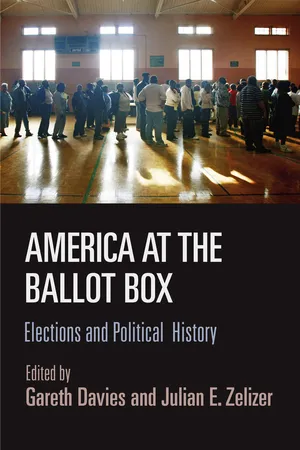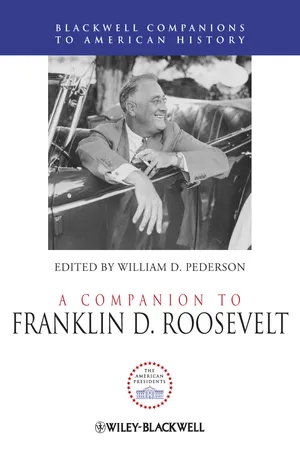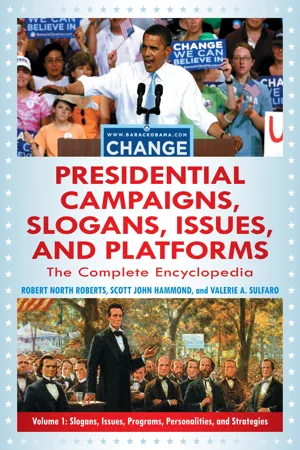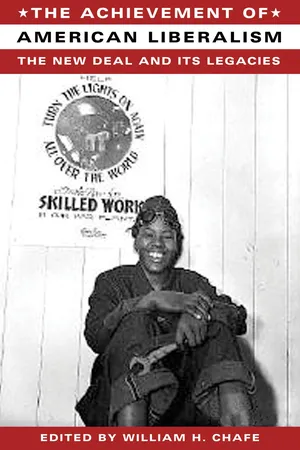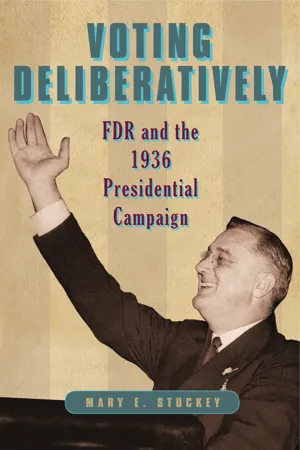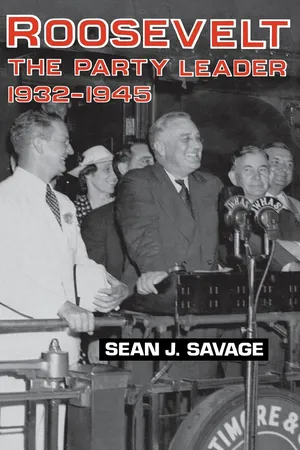History
1928 Presidential Election
The Presidential Election of 1928 in the United States saw Republican candidate Herbert Hoover defeat Democratic nominee Al Smith. Hoover's victory marked the continuation of Republican dominance in the White House, as he won by a significant margin. The election is notable for being the first time a Catholic, Al Smith, ran for president on a major party ticket.
Written by Perlego with AI-assistance
Related key terms
1 of 5
9 Key excerpts on "1928 Presidential Election"
- eBook - PDF
Bylines in Despair
Herbert Hoover, the Great Depression, and the U.S. News Media
- Louis W. Liebovich(Author)
- 1994(Publication Date)
- Praeger(Publisher)
The 1920 election had revolved around the League of Nations issue and resulted in the election of Harding, who has proved to be the weakest president of the twentieth century. The 1924 election had been a foregone conclusion, with the divided Demo- crats practically conceding to Coolidge before the campaign began. Not since Woodrow Wilson had come from behind to narrowly edge out Charles Evans Hughes in 1916 had the country been so galvanized by two credible candidates. The campaign seemed to center around four issues: the personalities and contrasting backgrounds of the candidates, Smith's Catholicism, Pro- hibition, and the state of the nation's economy. Of the four, prosperity was the overwhelming influential issue, though Smith's Catholicism and the personal contrast between the two brought more discussion and de- bate in newspapers and magazines. Editors and reporters did not pay as much attention to Prohibition, because Smith was clearly wet and Hoover clearly dry. Either the opinion makers agreed or disagreed, and by 1928 the pros and cons of the Eighteenth Amendment had been debated for nearly ten years. Usually, even if the editorial board disagreed with the Prohibition stance of the candidate, they overlooked that position and supported the candidate with whom they agreed on other issues. In Oc- tober 1928 the Chicago Tribune, headquartered in the hometown of the nation's most notorious bootleggers, observed: "We disagree emphati- cally with Mr. Hoover's present view of prohibition, but the problem The 1928 Election 69 presented by prohibition and its attempted enforcement is insoluble in this campaign." 66 Smith's Catholicism, however, was another matter. Newspapers usually tried to argue that religion was not a factor in their editorial endorse- ments of the candidates, and probably this was true in many cases. But the 1920s were not far from the day when East Coast newspapers looked the other way as businesses refused to hire Irish Catholics like Smith. - Katherine A.S. Sibley(Author)
- 2014(Publication Date)
- Wiley-Blackwell(Publisher)
The Future of American Politics (Lubell 1965; originally published in 1951). Lubell primarily considered the urban vote, especially the net increase on the Democratic side, in presidential elections from 1920 to 1948. He noted the great gains by Franklin D. Roosevelt after becoming president and singled out the 1928 election as the one where the Democrats first gained a plurality in all of the twelve largest cities. This led to his oft-quoted observation that, “Before the Roosevelt Revolution there was an Al Smith Revolution” (1965: 49).Other political scientists established a theoretical framework for their analysis of the 1928 election. V.O. Key, Jr., led the way with a widely discussed article in which he defined the concept of “critical elections” – those which produce a motivated electorate and result in a realignment from the political norm preceding them (Key 1955). He found that the 1928 election fit his definition, at least in the New England states from which his data was derived. Over the next twenty years, scholars continued to produce data to demonstrate, in most cases, how the 1928 election conformed to this pattern. Along the way, several works were published that further expanded the “critical election theory” originally posited by Key. Included were studies of election outcomes in several states, as well as a major article on the election in the cities by distinguished historian Carl Degler (1964). Two authors of a study on urban political realignment in the late 1920s and early 1930s, Jerome M. Clubb and Howard W. Allen, edited a collection of writings on the subject, published in 1971 as Electoral Change and Stability in American Political History, which serves as a convenient compilation documenting the development of the literature.A pair of articles in historical journals in 1975 and 1976 challenged the designation of the 1928 contest as a “critical election.” In reviewing the literature on the subject, Bernard Sternsher castigates some historians who, “in accepting the election of 1928 as critical, have overlooked findings by historians and political scientists which vitiate this concept” (Sternsher 1975: 127). He points to faulty logic and assumptions in many of the studies of what he refers to at one point as “the 1928 ‘mess.’” (1975: 128) His overall concern is whether the quantitative voter analysis too quickly pushed historians and political scientists to draw the sweeping conclusions that they had about political behavior and the history of political parties. He expressed concern that “the party-systems framework resting on the examination of election returns can become a methodological Procrustean bed. To get at the ‘why’ of voter behavior we must probe more deeply and in greater detail than the discernment of party systems and the typologizing of elections according to voter alignments in aggregate terms” (1975: 147).- eBook - ePub
America at the Ballot Box
Elections and Political History
- Gareth Davies, Julian E. Zelizer, Gareth Davies, Julian E. Zelizer(Authors)
- 2015(Publication Date)
- University of Pennsylvania Press(Publisher)
For scholars of American politics more generally, the national campaigns of the 1920s have occasioned little interest on their own terms. They draw attention mainly as fodder for debates over the preceding era—arguments over the persistence or collapse of Progressive reform—or as harbingers of future developments, such as the emergence of the New Deal coalition. Those latter interpretations focus on conflicts within the Democratic Party. While the Republicans nominated Coolidge practically by acclamation, the Democrats split badly. During the party’s 1924 convention—held in a roasting, unair-conditioned Madison Square Garden during a New York heat wave—the Democrats deadlocked for sixteen brutally hot days. Divided between its cosmopolitan, urban, ethnic wing, which opposed Prohibition and rallied behind Al Smith, the Roman Catholic governor of New York, who was of Irish immigrant stock, and the rural, Protestant, Prohibitionist southern and western bloc that supported William G. McAdoo, the two factions fought over whether to condemn the Ku Klux Klan and over who to nominate for president. Ballot after ballot dragged on for weeks, but the rival wings could not agree. On the 103rd ballot, after the main contenders had withdrawn, the still-divided party compromised on the bland Davis. Several historians have depicted the convention as a pivot, a point of equilibrium between the old Democratic Party, personified by McAdoo and William Jennings Bryan, and the New Deal coalition embodied by Smith and Franklin D. Roosevelt. In this view, the defeat of McAdoo and the nomination of an explicit critic of the Klan point toward the modern liberal, urban Democratic Party that would take shape a decade later.That argument owes its origins to Samuel Lubell’s classic study, The Future of American Politics . In that 1951 book, Lubell, a prominent pollster who had worked in federal agencies during World War II, suggested that Al Smith’s unsuccessful presidential runs during the 1920s had planted the seeds for the assembly of the New Deal coalition and for an era of Democratic Party dominance in American politics. In particular, Lubell stressed growing Democratic strength in the nation’s cities. In 1920 the Republicans swept the nation’s twelve largest cities by a million and a half votes. Eight years later, however, the Democrats won the urban vote. Of course, this forward-looking account emphasized 1928 and Smith’s presence on the top of the ticket, an election where the Democrats carried the big cities but lost a significant chunk of the “Solid South.”16In recent years, political historians have refined and deepened this notion of the 1920s as incubator of modern American politics, seeing the period as herald not merely of imminent shifts in partisan affiliation but of broader changes in the style and structure of American politics. Brian Balogh casts the decade as the critical juncture in a half-century-long transformation from a politics of parties to a politics of interests. For Balogh, however, as for Lubell, the decisive shift does not arrive until Herbert Hoover’s 1928 presidential campaign. Unlike his predecessors, Hoover “rose to power outside of the party structure” and “was more beholden to interest group cues than partisan intelligence for his connection to voters.”17 - eBook - ePub
- William D. Pederson(Author)
- 2011(Publication Date)
- Wiley-Blackwell(Publisher)
Chapter Five THE ELECTION OF 1932 Donald A. Ritchie The process of deciphering the 1932 election began as soon as the campaign had ended. It quickly became a truism that the Great Depression had doomed Herbert Hoover’s chances of reelection and paved the way for Franklin D. Roosevelt’s presidency. Less attention was therefore devoted to why Roosevelt won than on whether or not his campaign adequately prepared the nation for his New Deal agenda. By all accounts, the 1932 election marked a watershed in American politics. The Great Depression profoundly shook American voters, forcing them to reexamine their political allegiances and expectations for the federal government. After being the dominant political party since the Civil War, Republicans were dethroned and Democrats became the majority party for most of the next half century. Herbert Hoover, who had won the presidency in a landslide four years earlier, lost it in an even greater electoral avalanche. Franklin Roosevelt swept into the presidency promising a new deal for the American people. Democrats added 99 seats in the House and a dozen new senators to give them overwhelming control of Congress, and a readiness to follow the new president wherever he led, to get the nation out of the economic crisis. Citizens’ expectations for the federal government expanded and new programs more directly connected the government to their daily lives. The relevant literature began a year before the election when Ernest K. Lindley, a New York Herald Tribune reporter who covered Roosevelt as governor, published an influential campaign biography, Franklin D. Roosevelt: A Career in Progressive Democracy (1931: 7–8, 355). Lindley denied that Roosevelt had solicited him to write the book, but its sympathetic assessment helped to boost his candidacy. In a second edition, released after the election, Lindley added a chapter on the Democratic nomination, reminding readers that there had been nothing inevitable about that outcome - eBook - ePub
Presidential Campaigns, Slogans, Issues, and Platforms
The Complete Encyclopedia [3 volumes]
- Robert North Roberts, Scott John Hammond, Valerie A. Sulfaro(Authors)
- 2012(Publication Date)
- Greenwood(Publisher)
One could also add Tilden to this company as the six Democrats between the party’s founding in the late 1820s–early 1830s through 1932 to have gained a majority of the popular vote in a presidential election. Roosevelt swept the South, West, and Midwest, and while Hoover won five of his six states in the Northeast (Maine, New Hampshire, Vermont, Connecticut, and Pennsylvania—his only other state being the border state of Delaware)—Roosevelt carried his home state of New York with its 47 electoral votes (10% of the total votes in the Electoral College) and again took what was now becoming a former Republican stronghold, Massachusetts, for the Democrats, thus repeating and reinforcing the trend that had been initiated by candidate Smith in the previous election. In the wake of such a devastating victory, Roosevelt and the Democrats now ruled the political landscape; the Republican Party, which had dominated the federal government since Lincoln, and which had as recently as the last three elections produced a string of landslides that made the party appear invulnerable, at least in presidential elections, was now in the minority. The middle decades of the twentieth century—those decades that were marked by the worst global crises in the history of humankind, the Great Depression, World War II, and the earliest years of the Cold War—in American politics were to be dominated by the Democrats. Additional Resources The American Presidency Project (http://www.presidency.ucsb.edu and http://www.presidency.ucsb.edu/ws/index.php?pid=29638#ixzz1IP4Mu8Pv). Brands, H. W., Traitor to His Class: The Privileged Life and Radical Presidency of Franklin Roosevelt (New York: Doubleday, 2008). Freidel, Frank, “Election of 1932,” in Arthur M. Schlesinger and Fred L. Israel, History of American Presidential Politics, 1789–1968, vol. 3 (New York: McGraw-Hill, 1971). Freidel, Frank, “1932,” in Arthur M. Schlesinger, Fred L. Israel, and David J - Available until 27 Jan |Learn more
The Achievement of American Liberalism
The New Deal and Its Legacies
- William H. Chafe, William Chafe(Authors)
- 2002(Publication Date)
- Columbia University Press(Publisher)
The modern Democratic Party, observers agree with near unanimity, emerged from the trauma of the Great Depression. For a twenty-year mo-ment in history, beginning with Franklin Roosevelt’s landslide victory over Herbert Hoover in 1932, it dominated American politics and served as a ve-hicle for an enormous social transformation that was abetted by an un-precedented growth in the functions and institutional structure of the na-tional government. What with the Depression, World War II, the onset of the Cold War, and the social restructuring that accompanied these phe-nomena, it seems natural enough to call these two decades a watershed in American history. 1 The Democratic high tide, however, might equally be considered a peak in which a long-established political party, with a polyglot constituency and an amorphous policy direction, displayed unexpected resources to lead the American nation through one of the most critical periods of its history. The special character of this era in Democratic history is illustrated by a telling statistic: in 1932, Roosevelt was the party’s first candidate for president since Franklin Pierce (in 1852) to win more than 50 percent of the total popular vote. FDR would do it four times. Only two Democrats have managed it since—Lyndon Johnson in 1964 by an enormous margin and Jimmy Carter in 1976 by a scant half a percent. To an enormous degree, the Democratic success of the 1930s and 1940s was less a matter of national identity and or-ganizational strength than the personal charisma and strong leadership of one president—who in the end valued policy achievement over party. 2 HIGH TIDE: ROOSEVELT, TRUMAN, AND THE DEMOCRATIC PARTY, 1932–1952 Alonzo L. Hamby Begun in the 1790s as an alliance between southern agrarians and north-ern city politicians, the Democratic Party could locate both its greatest strength and greatest weakness in the diversity of its adherents. - eBook - PDF
Voting Deliberatively
FDR and the 1936 Presidential Campaign
- Mary E. Stuckey(Author)
- 2015(Publication Date)
- Penn State University Press(Publisher)
Going into the 1936 campaign, then, the nation had been long consumed with conversations about the damaged economy and how best to repair it, about the national government and how much power to give it, and about the nation itself and how best to lead it. Roosevelt had a wide-ranging, if not always coherent, set of answers to these questions. His various opponents had a vari- ety of objections to his policies and a broad range of alternatives. The election was, therefore, practically a textbook case of the possibilities for deliberation in a democratic republic. It was a referendum on the president and a test of the relationship he had forged with the American people. It was also a proving 14 voting deliberatively ground for his theories of governance—theories that turned on the new cul- tural emphasis on science and efficiency, manifested in public-opinion polls; that depended on the mobilization of the mass public; that understood the pub- lic as composed of economic and ascriptive groups; and that sought to unify those groups through an avowedly nationalistic set of rhetorical appeals. The 1936 election validated both these theories and the president’s leadership and proved to be the pivotal moment in the creation of the New Deal coalition and the practice of American elections. The 1936 Campaign We think of presidential campaigns as confined processes, engaged in between candidates from two major parties who seek to influence voters in specifically targeted states. They are, however, also more than that. They are national con- versations about the policies, parties, and people who will govern the nation, and they involve members of the mass public, organized by party but also along the lines of interest groups and demographics, as well as unaffiliated and sometimes even uninterested citizens. Elections are opportunities to engage in debate as well as to make decisions. - Halford Ryan, Halford Ryan, Halford R. Ryan(Authors)
- 1993(Publication Date)
- Praeger(Publisher)
HERBERT HOOVER, 1929 83 hopes for continued prosperity and peace. This content was reinforced by a contemporary style, logic, and method of arrangement. 3 THE 1928 CAMPAIGN During the 1928 campaign, Hoover gave relatively few orations. He presented a lengthy acceptance speech, six campaign addresses at dif- ferent sites around the country, and a short radio talk to the nation. In these speeches, Hoover advocated taxation reform and business regu- lation to maintain a competitive system, sweeping reform of the judicial system, reorganization of the federal government for efficiency and econ- omy, and policies to help agriculture and labor. Moreover, he called for free and universal education and to preserve equality of opportunity. Above all, Hoover projected an optimistic tone that the United States was entering a new age of economic prosperity and moral development. 4 Hoover tried to finesse the issue of Prohibition by referring to it as "a great social and economic experiment, noble in motive" but imperfect in implementation. Although many citizens were adamantly opposed to ending the experiment, Hoover created the impression that he would reform the abuses of enforcement, and several newspapers urged their readers to vote for Hoover in order to make Prohibition more palatable. During the campaign, Hoover clearly stood for continuation of the Eight- eenth Amendment; his opponent, Al Smith, stood for repeal. Smith, however, focused most of his rhetoric on reforming federal agricultural policy and attacking Republican favoritism to big business. In actuality, Smith did not have many effective issues to use against Hoover. Both favored governmental reorganization, tariff revisions, and noninterven- tion in Latin America. While Hoover did not attack Smith for his Ca- tholicism and opposition to Prohibition, Republican underlings did.- eBook - PDF
Roosevelt
The Party Leader, 1932-1945
- Sean J. Savage(Author)
- 2014(Publication Date)
- The University Press of Kentucky(Publisher)
17 To stimulate a nationwide bandwagon effect behind Roose-velt's candidacy, Farley and Howe created the impression that Roosevelt's nomination was inevitable by distributing polls indicating the widespread support for Roosevelt among lead-ing businessmen as well as delegates and alternates who attended the 1928 national convention. 18 Throughout the preconvention campaign, Roosevelt attracted a broad coali-tion by advocating greater federal intervention in the econ-omy to relieve poverty and unemployment and end the Depression while promising to cut federal spending, balance the budget, and reduce the size of the federal bureaucracy. 19 Columnists portrayed the New York governor as an unprin-cipled opportunist, but his dichotomous rhetoric enabled him to maintain the support of states' rights conservatives in the South while attracting the support of Democrats and dis-affected Republicans, who demanded greater federal efforts to combat the Depression than the Hoover administration was employing. 20 Because only about 34 percent of the voters were registered as Democrats in 1932, the Party would need a candidate who had proven his ability to attract the votes of Republicans and independents. 21 Although Al Smith would not publicly announce his presi-dential candidacy until February 1932 when he entered the New Hampshire primary, Roosevelt and his campaign aides had always suspected that Smith would challenge Roosevelt 106 Roosevelt the Party Leader for the nomination. As early as 1931, anti-Hoover sentiment and a desperate desire for a change in presidential leadership had become so widespread that virtually any Democratic nominee could win the 1932 election. For the first time in fourteen years, the Democrats won a majority of seats in the House of Representatives, while reducing the Republican majority in the Senate to one seat in 1930. 22 With such favor-able electoral developments for the Party, it would be difficult for Smith to resist entering the race.
Index pages curate the most relevant extracts from our library of academic textbooks. They’ve been created using an in-house natural language model (NLM), each adding context and meaning to key research topics.


